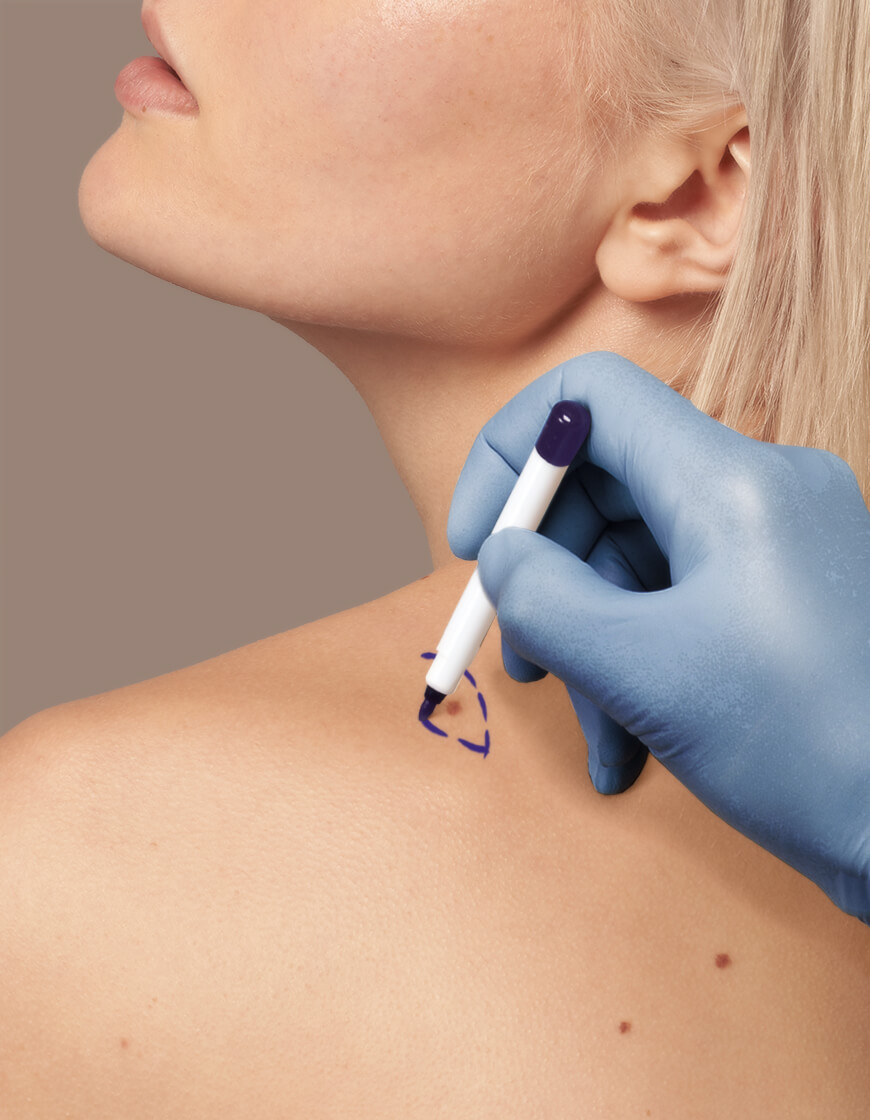Skin Cancer Treatment Singapore
MELANOMA
Melanoma is a potentially serious form of skin cancer that arises from the uncontrolled growth of melanocytes, the pigment-producing cells in the skin. It occurs due to genetic mutations in melanocytic stem cells, which cause them to multiply rapidly. Melanoma can develop anywhere on the body, either from an existing mole or as a new growth.
In its initial stages, melanoma spreads within the epidermis, a process known as radial or horizontal growth. Over time, further genetic changes can lead to an invasive melanoma that penetrates the dermis, breaking through the basement membrane. Once melanoma cells reach the dermis, they can spread to other tissues through the lymphatic system or bloodstream, potentially affecting the lymph nodes, brain, lungs, and other organs. This advanced stage is known as metastatic melanoma. The likelihood of metastasis depends on the depth of skin penetration.
Melanoma typically presents as a change in the size, shape, or colour of an existing mole, but it can also appear as a new mole. If you notice any changes to your skin, it’s essential to seek medical advice. Diagnosis involves a biopsy to detect cancerous cells. Scheduling a skin cancer check in Singapore is critical for early detection.
THE ABCDEs of Melanoma:
Going for a skin cancer screening in Singapore enables early detection, which is imperative in the treatment of Melanomas. If you’re performing a mole check, keep an eye on the following ABCDE features:
- Asymmetry: When one side of the mole’s shape does not match up to the other half.
- Border Irregularity: When edges are blurred in their outline or when ragged or notched. This pigment can spread into the surrounding skin.
- Colour Irregularities: Different shades of black, brown and tan, with areas of grey, white, red, or blue present.
- Diameter: Typically, there is an increase in size. Melanomas are small, but most can be bigger than the size of a pea (larger than 6 mm).
- Evolving: The mole’s shape, size, or colour has altered over time. This includes symptoms such as bleeding, pain, or itch.
Many melanomas show all of these characteristics, though some may only display one or two features. In advanced cases, the mole’s surface may change texture, becoming hard, lumpy, or ulcerated. It may also bleed or ooze. For instance, the surface skin may break down and look scraped. In some instances, melanomas can be painful, itchy, or tender to the touch.
To learn more about recognising cancerous moles, watch this helpful video that talks about skin cancer treatment, types, and more:

SKIN CANCERS (NON-MELANOMA)
NON-MELANOMA SKIN CANCERS (BCC, SCC AND SCC-IN-SITU)
There are different types of skin tumours and growths you should check for – not all skin cancers are melanomas. While some are harmless and require no treatment, some are cancerous and should be detected and removed early. Some common malignant skin tumours are non-melanoma skin cancers. These skin cancers include squamous cell carcinoma (SCC) and basal cell carcinoma (BCC).
BASAL CELL CARCINOMA (BCC)
BCC is one of the most common types of skin cancer. It develops gradually and can be painless, often going unnoticed in its early stages. BCC usually presents as a non-painful, persistent ulcer with a raised, pearly border, sometimes referred to as a rodent ulcer. For Asians, BCC can appear pigmented, while in fairer skin types, it often lacks pigmentation. These cancers typically occur on sun-exposed areas such as the face or upper limbs.
While BCC rarely spreads to other parts of the body, it can cause significant local damage if left untreated, slowly eroding into surrounding skin and underlying structures like bone and muscle. Chronic sun exposure is a major risk factor, along with chronic arsenic exposure. The tumour rarely metastasises to regional lymph nodes or distant organs but causes morbidity by local tissue destruction and may lead to subsequent disfigurement or functional impairment. Regular skin cancer checks can help detect BCC early, preventing complications.
SQUAMOUS CELL CARCINOMA-IN-SITU (BOWEN’S DISEASE)
SCC-in-situ, also known as Bowen’s Disease, is an early-stage form of SCC where malignant cells are confined to the upper layer of the skin (epidermis). It presents as a scaly, red plaque that resists treatment. Though easily treatable, early detection and treatment are crucial to prevent further spread.
SQUAMOUS CELL CARCINOMA (SCC)
SCC is a malignant skin tumour that affects the keratinizing cells of the epidermis or its appendages, as well as that of mucous membranes with squamous epithelium. Unlike BCC, SCC is more aggressive and has a higher risk of spreading to regional lymph nodes and distant metastasis. It often appears as a fleshy, irregular growth on sun-exposed skin. Over time, the growth can increase in size, giving rise to a lump, which may break down to form an ulcer in some cases.
Chronic sun exposure is a significant risk factor for SCC, as is exposure to chronic arsenic. Other contributing factors include chronic immunosuppression, such as that experienced by organ transplant recipients or individuals on immunosuppressive medications. Chronic non-healing wounds and ulcers can also increase the risk of SCC development. Regular skin cancer screening is essential for catching these growths early.
SUSPECTING SKIN CANCER? HERE’S WHAT YOU SHOULD DO:
If you notice any unusual skin changes, it’s important to consult a doctor for a proper diagnosis. A biopsy is usually performed to confirm the presence of skin cancer and determine its type. Treatment options in Singapore depend on the co-morbidities, histological subtype, patient preference, size, and location. They may include:
- Wide excision
- Mohs micrographic surgery
- Cryotherapy
- Topical therapies
- Photodynamic therapy
- Radiotherapy
If you’re seeking skin cancer treatment or need a mole check in Singapore, consult a specialist for personalised care. Early detection through skin cancer screening is key to effective treatment and recovery.
FAQ
- People with a family history of skin cancer
- People who were previously diagnosed with skin cancer
- People with a low immune system
- People living in sunny, tropical climates or high altitudes
- People with fair skin and who tend to burn under the sun
- People who have many moles or abnormal moles (dysplastic nevi)




